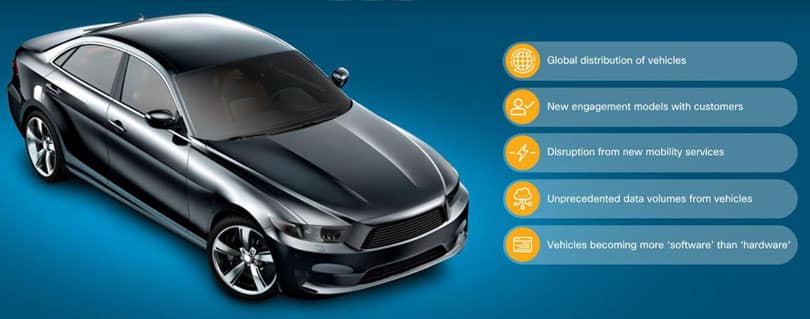

DRIVING PROFITS FROM CONNECTED VEHICLES
Exponential traffic growth from changes in the automotive industry offers new revenue opportunities
New connections lead to new opportunities
Every day, more connected vehicles hit the road sharing more data than ever before. In fact, according to the Cisco Visual Networking Index, connected vehicles that incorporate applications such as fleet management, in-vehicle entertainment, Internet access, roadside assistance, vehicle diagnostics, navigation, and advanced driver assistance services will be the fastest-growing industry segment in terms of machine-to-machine connections. According to SAS, between features in new cars and aftermarket devices, there could be nearly 2 billion connected vehicles on the world’s roadways by 2025. Unlike cellular phones that are replaced every few years, most vehicles have a service life of around 15 years, which means soon almost every vehicle on the road will be connected in some way. Because the connected vehicle of 2019 isn’t the same as one that will be built in 2034, vehicles will have a range of capabilities that need to be supported.
Modern vehicles are already connected to service provider networks using cellular technology for a range of applications. The rise in connected vehicles will affect upcoming 5G architectures because of the data volumes that the collective fleet of personal and commercial vehicles will generate. Instead of dreading the increased strain on their networks, service providers should consider ways they can work with the automotive industry in mutually profitable ways. If service providers can devise innovative approaches to incorporate their services into the automotive value chain, they have a unique opportunity to become far more than just a pipe for connected vehicle data.
More vehicles, more sensors, more data
Connected vehicles have network access so the vehicle can share information from tire pressure and mechanical systems to navigation, geolocation, and cameras. The data about the mechanical state, performance of the vehicle and the driver’s preferences can be used to help make driving safer and more enjoyable.
Although future production vehicles will generate increasing amounts of data, much of the data generated from an array of sensors and electronic control units within the vehicle will be recorded and processed locally. Most of the information will be discarded; only valuable data will be transmitted back toward the vehicle manufacturer.
Even though much of the data may not leave the vehicle, it’s clear that data volumes from vehicles will rapidly outstrip that of smartphones. Cumulative data volumes from the connected vehicle fleet will place considerable stress on communications network infrastructures with just one connected vehicle potentially generating as much data as 5.2 smartphones.
Data and duty cycles
Roads carry a variety of vehicle types, and similarly connected vehicles aren’t all the same. Vehicles may range from heavy-duty freight haulage to public transit services and motorcycles. The amount of information the vehicle transmits to the vehicle manufacturer and when it takes place varies considerably. The data volume differs from manufacturer to manufacturer, the type and model of the vehicle, and what the vehicle is designed to do. A fleet vehicle may generate two data streams, sending data to both the vehicle manufacturer and to the fleet operator.
In the automotive industry, a day or duty cycle is the usage of that vehicle within a 24-hour period. In the United States, the average personal light vehicle travels just over 11,200 miles per year. With an average of 261 working days per year, cars go approximately 43 miles per day with an average transit time of 53.8 minutes.
However, a personally owned car that’s driven twice a day for a commute to work doesn’t have the same duty cycle as a bus that’s on the road 18 hours a day. The duty cycle for different types of vehicles varies widely. For example, public transport and freight vehicles need to be in operation for a significant portion of a 24-hour period.
By way of comparison, in the United States in 2016 almost 11.5 million trucks were registered with a growth rate of approximately 400,000 new trucks being registered each year.The fleet accrued over 285,000 million vehicle miles traveled.
For industries such as freight haulage, telemetry is an increasingly valuable asset because it helps improve the operating efficiency of vehicles and the safety of drivers. Performing data analysis on individual driving patterns and behavior, traffic on routes, and weather conditions can yield actionable insights that can reduce time in transit and avoidable idle times. More directly, a 2013 report identified that fuel represents 39 percent of the annual operating costs of the average truck in the United States with an average running cost of $180,000. Reducing fuel usage across an entire vehicle fleet by as little as 2-3 percent can have significant financial and environmental benefits.
Today’s cellular networks are able to support the relatively small duty-cycle data volumes. However, as connected vehicles become increasingly prevalent and the duty-cycle data volumes increase, the cellular network operators and vehicle manufacturers will have to find ways to support cost-effective deployments at a global scale.


Service providers face challenges
Service providers continue to face intense margin pressure just to provide basic consumer connectivity. Traditional sources of revenues aren’t going to be enough to offset the costs of building out new infrastructure for 5G. To remain competitive, service providers must seek out new revenue opportunities and partnerships. The automotive industry is an area where service providers can offer unique advantages. If service providers can gain a better understanding of the connectivity, compute, data storage, distribution, and security needs of the automotive industry, they can devise creative ways to work together.
In the networking industry, you hear about edge computing a lot. Edge computing is the architectural principle of moving services to locations that can improve application performance and reduce transport costs instead of transporting vast amounts of data to a centralized data center.
As a service provider, you’ve probably implemented edge computing solutions to improve the quality of experience for your customers and to reduce operational costs. Because certain user applications benefit from edge computing, service providers are using multi-access edge compute (MEC) to position data center functions closer to users.
For service providers, implementing and operating an edge infrastructure is part of their business. This distributed architecture offers huge advantages for automotive companies that are concerned about data transport costs and redundancy. Often automakers sell vehicles all over the globe, but ship vehicle data back to a few centralized data centers. This approach is expensive in terms of transport costs and has high-availability implications. With a more distributed architecture, any service disruption is localized to a smaller set of vehicles within an area, rather than affecting a much larger portion of the entire vehicle fleet.
Service providers are upgrading their networks to prepare for 5G, and the increased bandwidth will be required to support automotive deployments. Data from vehicles will pass over multiple access mechanisms (including WiFi), which will need to be managed into a 5G network slice. Service providers and vehicle manufacturers have opportunities for collaboration in terms of how network slices and the services within the slice are contracted, operated, and monitored.
The connected vehicle market is growing and changing rapidly, but even now, opportunities exist for service providers in two key areas: telemetry and infotainment.


Telemetry opportunities
Connected vehicles may have lots of sensors, but data isn’t useful if it isn’t analyzed. Not all data is important and not all of it is useful. The telemetry data streams need to be analyzed to gain context and insights. By analyzing and combining the information with other data, automakers can make intelligent decisions and discover new opportunities.
Vehicle telemetry can give manufacturers insights into the operational behavior and performance of the vehicle. It also can help them understand their customer base in greater detail. Telemetry can help to address issues for vehicles both on the road and on the production line, which can reduce the number of vehicles affected by recall and warranty costs. According to a McKinsey report, the number of recalls related to electronic and electrical systems has risen nearly 30 percent per year since 2013, compared with 5-percent annual increases from 2007- 2013. The amount of software in vehicles has increased with some vehicles now having well over 100 million lines of code. Because of the increase in software, detecting and mitigating issues that affect the fleet is vitally important to manufacturers. Performing over-the-air (OTA) software and firmware updates has the potential to be able to address these issues.
Vehicle fleet operators often gather their own telemetry, independent of vehicle manufacturers by incorporating their own sensors and communications equipment into their fleet of vehicles. Fleet operators’ use of telemetry is a direct input into business operations, which can help drive efficiency improvements and profitability. For freight haulers, their vehicle fleet must spend most of their time in motion moving goods. Their areas of focus include:
> Idle time. Any time a vehicle isn’t moving, such as when it’s being unloaded, it costs money. If a vehicle misses its slot at a distribution center and has to wait, time is lost along with profits. Even processes such as presenting identification and providing manifest information is an area for optimization. Data transmitted between the vehicle and the distribution center can ensure that slots aren’t missed, which leads to efficiency improvements on all sides.
> Fuel costs. Fuel is one of the primary costs for haulers. Saving even a small percentage can make a difference in profitability. Tracking issues such as headwinds and other weather events can lead to fuel savings. Using telemetry from their fleet, companies can make routing decisions to avoid bad weather, but it requires access to near-real-time information and processing capability.


Infotainment opportunities
Infotainment is another key area of opportunity from connected vehicles. In-vehicle infotainment continues to evolve, and many automakers include high-resolution touch-screen capabilities and an automotive navigation system. Some manufacturers offer broadcast television receiving functions or the ability to run smartphone-like applications for passengers. Advanced concepts that are starting to be experimented with include using augmented reality approaches to decorate windows or screens within the vehicle that show information such as traffic, location of services, weather, and targeted advertising.
In the automotive industry, there is a debate about the vehicle manufacturer’s role in infotainment. One camp says that vehicle manufacturers have no role to play. The car acts as an advanced paired Bluetooth accessory, so users can play media from a connected personal communications device. A key tenant of this approach is that users pay for their consumption of media and navigation services because they use the data plan associated with their personal communications device.
The alternative position suggests that the vehicle manufacturer participates in infotainment by offering a variety of integrated and connected experiences. Some vehicle manufacturers include such services as part of a cellular data plan that owners purchase independently from their personal communications devices. Other manufacturers include a cellular data plan as part of the initial purchase with a renewal option after an initial period such as 1-3 years. Again, the user is paying for the data, directly or indirectly. Participating in the infotainment value-chain can lead to additional revenue for the vehicle manufacturer in a number of ways such as from:
> Premium services from content providers that are experienced by the passengers in the vehicle, rather than the driver.
> Location-based information and advertising, similar to location-based ads on cell phones.
Partnering for success
Because of the major changes in the automotive market arising from the increase in connected vehicles, opportunities exist for new revenue-sharing or revenue-generating relationships with service providers. Service providers need to look for these opportunities and ask:
> What existing solutions do you have that you can build upon?
> What assets do you already have that you can leverage for this sector? For example, an edge compute capability that vehicle OEMs don’t possess or multi-access points such as cellular coverage and Wi-Fi hot spots that could better facilitate and reduce costs of data transmissions.
> What new opportunities and partnerships could you explore? For example, partnering with parking structure operators by installing managed Wi-Fi service for better coverage.
> Are there areas of potential cost savings for vehicle manufacturers?
> Are there new revenue streams that you can build together with vehicle manufacturers?
Based on the current generation of connected vehicles, here are some areas of potential opportunity:
> Today, much of the telemetry from connected vehicle is transported back to centralized data centers for processing. The automaker benefits if the computation of the telemetry is performed closer to the location of the vehicles because it results in a reduction in the data volume to be transported and processed.
> Some types of infotainment such as video benefits from delivery points that are closer to the vehicle. Video traffic could be tagged by the network to ensure the quality of experience for this type of traffic.
> Automakers and companies with global vehicle fleets benefit from working with a single communications service provider with global partnerships. Rather than working with different service providers across territories, it can be advantageous to them to partner with a single service provider with a geographically distributed network.
Other revenue generating ideas for service providers may not be obvious today. In evaluating possibilities, what assets do you have as a service provider that other cloud-based businesses don’t have? For example, look at ways you can:
> Monetize your data. For example, if you run a fleet of trucks, you can take the weather-related telemetry data from your own fleet and resell it.
> Reduce costs to carmakers. As a service provider, do you have compute capacity in geographic locations that are closer to where vehicles are located? Do you have data center capability you could offer to automotive manufacturers for less than they’re paying now?
> Insert your business into the automotive value chain. For example, do you have applications that offer extra services for automakers that could become part of their value chain? Instead of simply transporting data, could automakers benefit from applications running in a data center that has physical proximity to their cars?
> Offer extra services. If you have a distributed network of data centers, can you provide high-availability or redundancy services, so that if one data center goes down, it affects a smaller number of vehicles?













